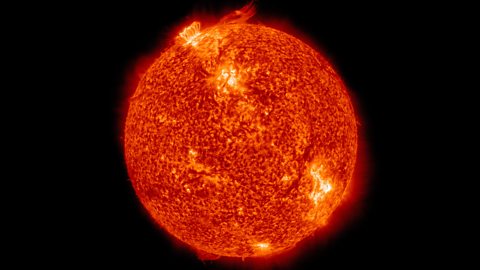The Sun
The Solar System was formed around 4.6 billion years ago from a large cloud of dust and gas, called a nebulaA cloud of gas and dust in outer space. If massive enough, these can collapse under gravity to form a protostar.. This collapsed under its own gravity, transferring potential energyPotential energy, in this instance, is associated with gravitational potential energy - the energy gained while rising a certain height. Measured in joules (J) . For example, the cable car gained potential energy as it rose into the mountains. to kinetic energyEnergy which an object possesses by being in motion. in its particles. As the nebula collapsed it became denser, and rotated more rapidly. Collisions between particles caused kinetic energy to be transferred as internal energyEnergy stored in all materials, including energy due to the motion of particles and the chemical bonds between them. and thermal energyA more formal term for heat energy.. The core of the nebula began to form a hot, dense protostarThe early stage in the formation of a star, before nuclear fusion occurs..
When the SunÔÇÖs core became hot enough and dense enough, nuclear fusionThe joining together of two smaller atomic nuclei to produce a larger nucleus. Radiation is released when this happens. Nuclear fusion happens in stars like our Sun, and in hydrogen bombs. reactions began, giving out energy and radiationEnergy transferred as a wave┬áspreading out from a source┬á- eg light, infrared, sound..
A star like the Sun is at equilibrium - gravity tends to pull it inwards, and radiation pressure from the nuclear reactions tends to expand it outwards. In other words, the gravitational collapse is balanced by the expansion due to fusion energy.

The Sun is currently a main sequenceA stable stage in the life cycle of a star. Nuclear fusion occurs, fusing hydrogen nuclei into helium nuclei. There is a balance between the outwards radiation and the force of gravity pulling inwards. star and will remain so for another 4-5 billion years. It will then expand and cool to become a red giant, after which it will shrink and heat up again to become a white dwarf. The white dwarf star will run out of nuclear fuel and slowly cool down over many billions of years.